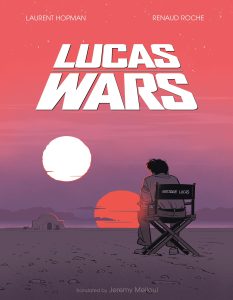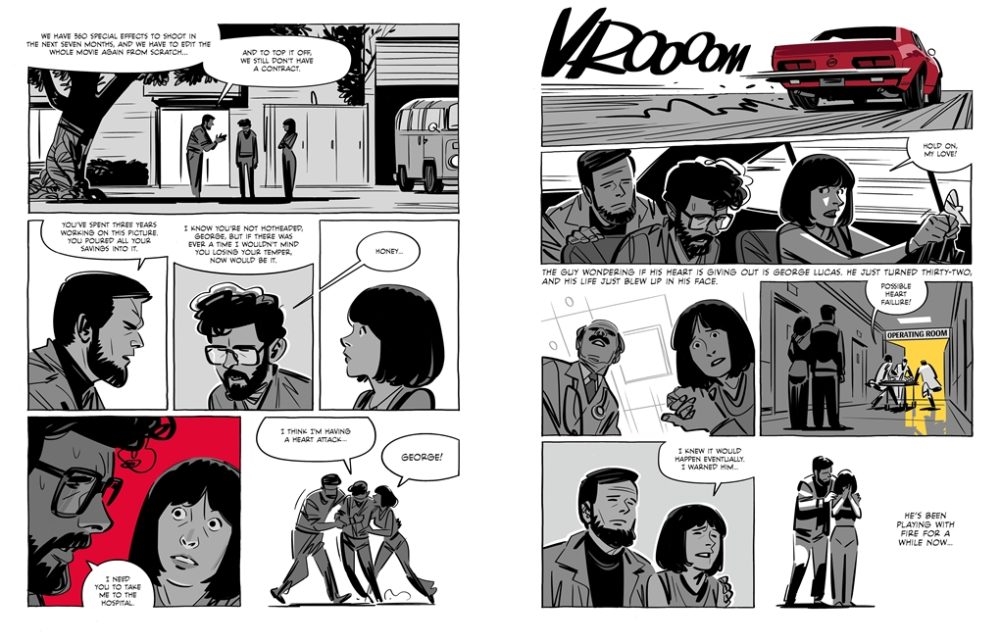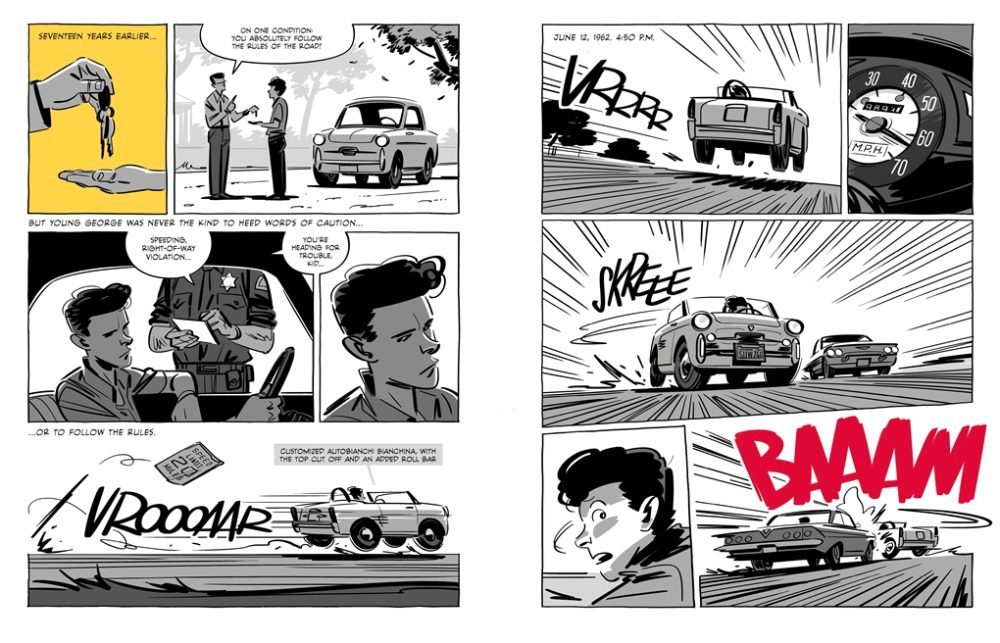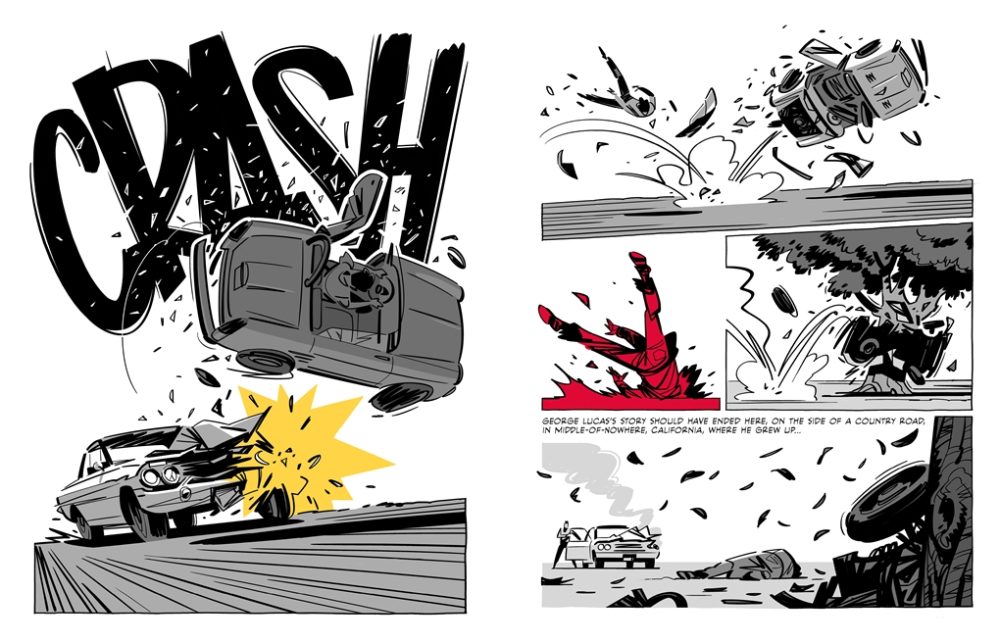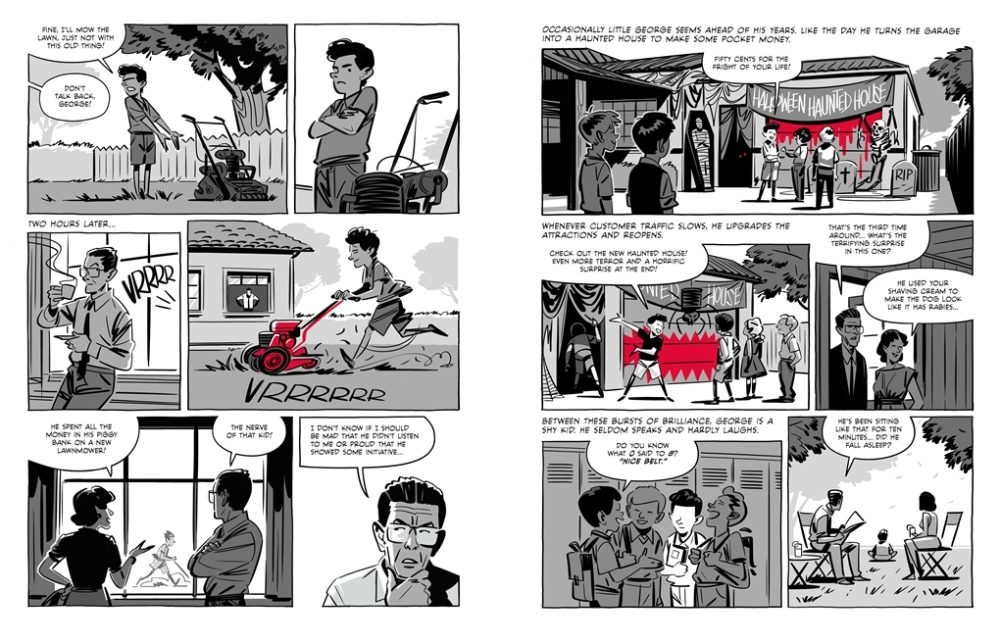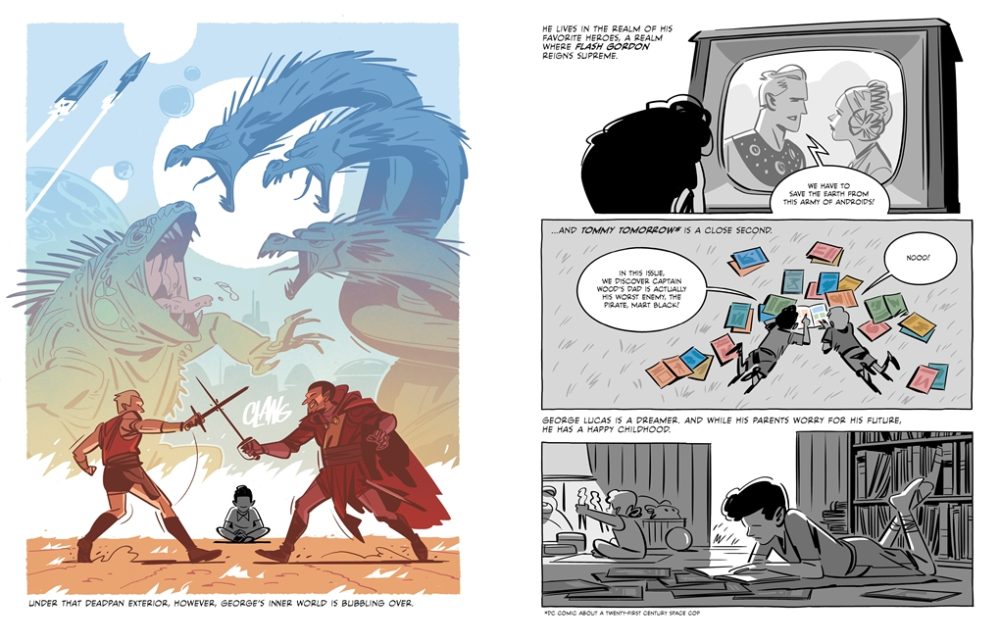 Lucas Wars
Lucas Wars
Writer: Laurent Hopman
Artist: Renaud Roche
Translator: Jeremy Melloul
Publisher: 23rd St.
Publication Date: September 2025
In Brian Jay Jones’s 2016 biography of George Lucas, the author offers a meticulously researched portrait of the filmmaker, tracing his evolution from a restless dreamer to the disruptive architect of cinema and culture Jones emphasizes formative experiences that shaped Lucas’s creative sensibilities: his childhood fascination with science fiction serials like Flash Gordon, his early experiments with 8mm cameras, and, most dramatically, his recovery from a near-fatal car accident. That incident crystallized a tension that would define much of his life—the struggle between his father’s practical expectations and his own artistic impulses. These early pressures would foreshadow Lucas’s legendary insistence on creative control, particularly during the making of Star Wars, where vision and commerce were in constant negotiation.
Laurent Hopman and Renaud Roche’s new graphic novel, Lucas Wars (published this month by 23rd St.), takes the story further by turning Lucas’s life into a gripping and beautifully illustrated graphic novel. It skillfully combines close-up portraits with epic storytelling. The comic doesn’t sugarcoat Lucas’s life, instead delving into the emotional and psychological ups and downs of the filmmaking journey. Dreams, ambition, insecurity, and collaboration are shown not as vague ideas but as real, often messy parts of the process. Lucas is portrayed as someone who’s both driven and unsure, whose creative successes are deeply connected to human vulnerabilities.
What makes Hopman’s biography stand out is that it’s not a dry recitation of dates and milestones. Instead, he crafts a narrative that gets to the core of Lucas, not just as this cultural icon, but as a person and a creative. Rather than attempting to cover every detail, Hopman zeroes in on defining moments. The book opens with Lucas’s near-fatal car accident as a teenager, not as a mere brush with death, but as a pivotal moment of reckoning that shaped his sense of urgency and purpose. From there, Hopman weaves together the threads of Lucas’s life: the boy in Modesto obsessed with gadgets, the restless student testing the boundaries of film at USC, and the determined young director battling to bring Star Wars into existence. Each chapter highlights Lucas’s resilience and daring, illustrating not only his vision but also his willingness to take risks when the odds were stacked against him.
Equally compelling is how Hopman portrays Lucas’s professional relationships. Francis Ford Coppola emerges not merely as a mentor but as a complex figure whose brash influence shaped Lucas’s confidence and ambition. Coppola’s encouragement to take risks, paired with his own high-stakes clashes with Hollywood studios, gave Lucas a template for artistic defiance. If Coppola showed him how to break rules, he also embodied the costs of doing so, and Lucas internalized both lessons. Steven Spielberg, meanwhile, appears as both collaborator and friendly rival, illustrating the strange alchemy of New Hollywood: filmmakers competing for box office dominance while freely borrowing ideas and offering support. Spielberg’s playful imagination pushed Lucas to loosen his often rigid instincts, while Lucas’s sense of structure grounded Spielberg’s flights of fancy. Their relationship reveals how rivalry, when balanced with trust, can be a fertile force in artistic growth.
These bonds highlight a larger truth: Lucas’s path was never solitary, even if his temperament often leaned that way. He was, at his core, a reluctant participant in the collaborative messiness of filmmaking. Hopman captures this tension through vivid scenes of creative exchange and subtle conflict. There are the notorious moments of passive-aggressive sparring with Alec Guinness, who bristled at Lucas’s direction and viewed the material with skepticism. Mark Hamill, eager but occasionally exasperated, clashed with Lucas’s famously flat affect and perfectionism.
Most striking, however, is the volatile chemistry between Carrie Fisher and Harrison Ford. Their affair during production was not a mere footnote but a significant factor in the tense atmosphere of the set. Fisher, grappling with youthful insecurities and later substance abuse, and Ford, entering midlife and seeking solace from a strained marriage, engaged in a passionate relationship that was as fraught as it was intense. This tension seeped into their performances, intensifying the onscreen dynamic between Leia and Han.
For Hopman, the Ford-Fisher affair is not presented as gossip but as evidence of the fragility and volatility inherent in the creative process. Personal entanglements bled into professional demands, turning Star Wars into more than a film set—it became a crucible where private vulnerabilities and artistic ambitions collided. What emerges, then, is not the myth of one man dictating his vision, but the reality of a cultural object shaped by friction, intimacy, clashing egos, and unlikely alliances.
Roche’s minimalist artwork strategically deepens the narrative. The mostly black-and-white drawings, interrupted by well-placed bursts of color, nod to the style of classic noir while still feeling fresh and distinctive. The use of color is especially striking: C-3PO’s golden armor gleams against the stark background, while the bright yellow cover of Joseph Campbell’s The Hero with a Thousand Faces jumps off the page, underscoring Lucas’s key influences. At first, the stripped-down backdrops might seem like an odd choice for a tale set in the endlessly detailed Star Wars universe. But that sparseness shifts the focus away from spectacle and toward the actual people, including their struggles, their determination, and the messy, often logically-obtuse side of filmmaking. By clearing away visual clutter, Roche directs the reader’s attention to the effort, risk, and quiet orchestration that make cinematic magic possible.
He brings the same care to the way he draws people. Without exaggeration or caricature, Roche captures familiar faces with subtlety and respect. Ford’s wry expressions, Fisher’s spirited presence, Hamill’s enthusiasm, and Lucas himself—sometimes weary, sometimes tense with focus, and often flashing that insouciant scowl—chart not just the toll of responsibility but the streak of defiance that fueled his creativity. That scowl becomes more than a look; it’s a reminder of Lucas’s resistance to compromise, a stubborn independence that both strained his collaborators and made Star Wars possible.
The comic’s exploration of Lucas’s psychology is particularly revealing. Far from portraying him as an invulnerable visionary, Hopman and Roche present Lucas grappling with financial pressures, creative doubt, and collaborative tension. A memorable moment—Marcia Lucas’s middle of the night suggestion to kill Obi-Wan (sorry for the spoilers, but doesn’t know?!)—illustrates how creative decisions emerged from compromise and negotiation, even under exhaustion and pressure. Scenes depicting Lucas’s clashes with Fox suits, or his direction of actors to perform “faster and more intense,” underscore the delicate tension between unfettered artistic vision and commercial reality.
Hopman also succeeds in dramatizing the interdependent nature of creativity. Coppola’s mentorship offers Lucas both inspiration and a cautionary model, showing how to navigate the studio system without compromising vision. Spielberg’s friendship and (friendly) rivalry further contextualize Lucas’s work, highlighting the collaborative ethos of the era while illustrating how creative ambition thrives in dialogue and competition. These relationships offer a window into New Hollywood’s broader ecosystem, where innovation often emerged from shared risk, pressure, and spirited debate.
The behind-the-scenes production drama adds texture and relatability to the narrative. Tensions among the cast, logistical hurdles, and inevitable technical failures don’t diminish the magic of the final film; they highlight just how improbable Lucas’s success really was. Even the smaller subplots—such as the friction between Anthony Daniels (C-3PO) and Kenny Baker (R2-D2)—reveal the very human negotiations and clashes that shaped the project. These moments remind us that Star Wars was not only a technical breakthrough but also a fragile collaboration of strong personalities. Yet the team also draws attention to the quiet victories along the way. John Williams’s soaring score, for instance, wasn’t just background music—it elevated the entire film, reasserting the power of orchestral soundtracks at a moment when Hollywood had largely turned to pop tunes and minimalist scoring.
Temporal shifts, such as flashbacks and flash-forwards, enhance the graphic novel’s cinematic quality, aligning with the Hero’s Journey framework that inspired Lucas. By structuring the narrative in this manner, Hopman crafts a meta-commentary on storytelling itself: the book embodies the principles of myth and narrative that underpinned Lucas’s most renowned work. Accessibility is another notable strength. Readers unfamiliar with Star Wars or the graphic novel medium can engage with the narrative, while enthusiasts gain nuanced understanding of the interplay between vision, labor, and personality that shaped the franchise.
Lucas Wars presents George Lucas as director, businessman, and flawed visionary. Blending biography, artistic experimentation, and psychological insight, it reveals his process without turning him into myth. The book celebrates his achievements while acknowledging the costs of pursuing an uncompromising vision. Rather than falling into celebrity hagiography, Hopman and Roche explore ambition, collaboration, and the volatile alchemy of filmmaking. They honor Lucas without idolizing him, creating a graphic novel that goes beyond a simple origin story of Star Wars. It captures the convergence of art, commerce, and determination that reshaped popular culture.
Stylish and engaging, Lucas Wars invites readers to reconsider Lucas and rediscover the wonder of that first galaxy far, far away.
Lucas Wars is out this month via 23rd St.
Read more great reviews from The Beat!



